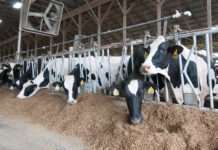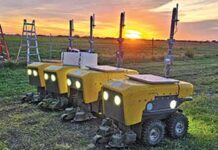Throughout most of the Sunflower State, fall crops wait for combines to begin harvest. Abundant rainfall during the last week of August and the first 10 days of September stopped any attempts to cut dry-land corn.
Water stands in low places in fields and ditches throughout much of western Kansas. Country roads sport ruts from the late summer rains.
While no Kansas farmer or rancher would ever turn down moisture of any kind, this delay means most of the fall corn, milo and soybeans may be all ready to harvest at the same time. This in turn could lead to a busy, hectic 2018 harvest with all farmers scrambling to harvest their grain before the weather turns to winter.
“By this time, we’d normally be in the fields harvesting dry-land corn,” says Ryan Reed, Gray County. “But I can’t bring myself to complain about the rain we’ve received. When it’s wet, it’s always better than the alternative.”
Reed farms with his brother in Gray, Haskell and Kiowa counties. The brothers represent the fourth generation to farm in southwest Kansas.
While they once farmed a third milo, wheat and summer fallow rotation, the last few years, they’ve flexed their dry-land and irrigated acres based on economics and moisture conditions. During the last 20 years, the family farm continues to transition from irrigated to dry-land farming.
Like so many southwestern Kansas farmers, the Reeds have been suffering from lack of moisture, and in some cases severe drought, since 2005. That said, they really appreciate this turn of weather fortunes. They’ll find a way to work around the moisture and prepare to go full-tilt boogey when fields dry out.
Still, with so much of the cropland saturated, wheat drilling season may also be delayed or shoehorned in during fall grain harvest. The Reeds normally shoot for the first week of October to begin wheat drilling. This year Ryan can only hope to find time to plant his wheat.
“Each fall we try to harvest all our crops and plant our wheat by Thanksgiving,” he says. “That’s always our goal, but this year it’ll be a mad dash to finish by the end of November.”
Expectations on the Reed farm remain high once the fall grain harvest kicks into high gear. Stands look outstanding. They’ve managed to control aggressive weed pressure brought on by the abundant rain. Now all they need is dry weather to combine the corn, milo and beans.
“We’re cleaning our bins like we intend to fill them up,” Ryan says. “Grain storage will be at a premium once the machines begin to roll.”
Fortunately, the Reeds maintain a massive storage facility on their farm. Unless it’s a bin buster beyond their expectations, they should have adequate room in their bins.
Like their neighbors and farmers across Kansas will tell you, the Reeds “never look a gift horse in the mouth.” This late summer’s rain trotted across much of the Sunflower State and crop producers will find a way to work around the wet spots while dreaming about newly planted wheat with plenty of subsoil moisture to propel it into 2019.
They’re mighty thankful.
John Schlageck is a leading commentator on agriculture and rural Kansas. Born and raised on a diversified farm in northwestern Kansas, his writing reflects a lifetime of experience, knowledge and passion.



